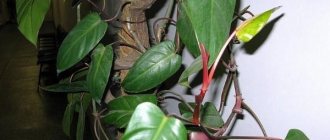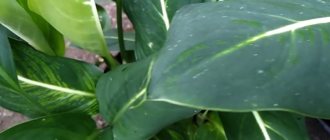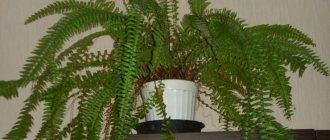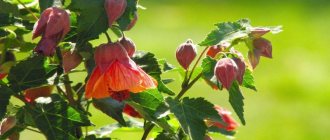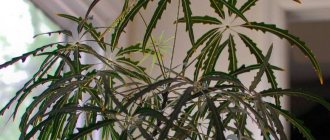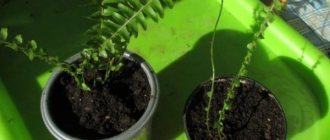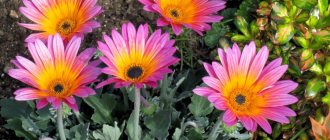Description
Philodendron leaves can be plain or spotted.
The genus of evergreen perennial philodendrons includes more than 200 species. Translated from Greek, the name of the plant sounds like “loves trees.” And this is no coincidence, because in nature, a plant living in tropical forests often looks like a vine and chooses strong trees for support.
Most varieties form thick aerial roots, like Monstera. They help the flower cling to support and reach for the light. Also, with the help of them, the plant receives nutrients and moisture.
Philodendrons can vary greatly in the appearance of their leaf blades. Large shiny leaves are dissected or heart-shaped, have different colors - from dark green to brown-red. Lianas have long thin stems, while other species have short stems.
Some varieties bloom even at home. It is worth noting that the sap of the plant is poisonous, so it should be grown with caution in areas where there are children and pets. Gloves should be worn when pruning or replanting.
Problems that concern philodendron owners
Errors in caring for plants, damage by pests and diseases manifest themselves in their appearance. For example, the reasons for the appearance of black spots on leaves can be: excess moisture, fungal diseases, mites or aphids.
And in very dry air, the tips of the leaves dry out and become brittle. The appearance of light spots on them is a sign of sunburn. Twisting them indicates an overdose of fertilizers. In a draft, the leaves turn black.
Stems and roots rot if there is high humidity in a cool room.
A very interesting phenomenon occurs when growing philodendrons - droplets of liquid form at the tips of the leaves. It is called guttation. This happens before rain, when there is excess moisture or high air humidity.
Popular varieties
Of the huge number of varieties of philodendron at home, the following are most common:
- Philodendron climbing has dense heart-shaped leaves up to 14 cm long. It is shade-tolerant and can be grown as an ampelous plant. The stem has clinging aerial roots.
- Philodendron Sello or bipinnate. It has large, emerald-colored leaves cut into lobes. They reach a length of 70 cm. This is the most decorative flower of this species, which is grown at home. It grows up to 2 m in height.
- Philodendron blushing is medium in size. The petioles have a reddish tint, the leaves are arrow-shaped and bright. Needs strong support and bright lighting, otherwise the leaves lose their saturation. Can bloom indoors.
- Philodendron Atom requires especially careful care. It has beautiful curled leaves, compact and lush.
- The golden-black philodendron has large, velvety, dark green leaves. They are streaked with gold and have a red underside. Requires intense lighting and high humidity, so it is more often grown in greenhouses than in apartments.
- Philodendron Xanadu is unpretentious, but beautiful leaves can only be achieved in bright light and high humidity. This variety can bloom indoors.
- Philodendron warty has beautiful velvety leaves up to 20 cm long. They grow on petioles with warty bristles.
The plant does not tolerate dry air well. Philodendron variety "Xanadu".
Types of Philodendron
More than 300 varieties of philodendron are known. Most often, only some of them are grown indoors. They differ significantly in the shape of the leaves, color and structure of the bush:
Philodendron climbing or clinging
Philodendron climbing.
Photo It is a variety of Philodendron ivy. It received its name for its long, thin shoots, equipped with numerous adventitious roots that develop from the axils of the leaves. With their help, the shoot crawls or climbs along a support at a distance of 4-6 m.
The color of the leaves is dark green or green with light splashes, the structure is dense, leathery, heart-shaped, pointed at the apex. The leaves reach a length of 15 cm and a width of 10 cm. Unpretentious, easy to care for, resistant to unfavorable growing conditions. Popular rumor dubbed Philodendron scandens muzhegon.
Philodendron blushing
The length of the shoot of an adult plant can reach 1.5-1.8 m; it does not branch; the vine crawls with the help of aerial roots. The leaves are large, up to 25 cm long, ovate, oblong, whole, dark green in color with a pinkish edge. The leaf is attached to the stem by a long petiole. Young shoots and leaves are reddish-brown, becoming greener with age, and the lower part of the stem develops into an upright, woody trunk. The plant does well in the shade.
Philodendron sello or bipinnate or doubly pinnate
Philodendron cello.
Photo It is distinguished by a tree-like stem covered with light-colored scaly depressions from the petioles of fallen leaves. The stem is erect and can reach a height of 2 meters or more. The leaf blade is wide (40-80 cm), ovoid, divided into pinnate lobes. Depending on the conditions of detention, the color ranges from light to dark green.
Philodendron lanceta
The stem is a flexible vine that requires constant support. The leaf plates are solid, shaped like arrowheads. The length of the leaves can reach 40 cm, the color is light green with a grayish tint.
Philodendron golden black or Andre
This is a powerful vine with long, up to 60 cm, dark green leaves with white veins. A dense copper tint gives the plant an original look. The look is suitable for decorating rooms with insufficiently bright lighting.
Home care
Philodendron is not too demanding on lighting and is easy to grow at home. The vines need to be provided with a strong support, wrapped in moss or coconut fiber. Indoors, vines bloom more readily than bushy species, but this requires proper care.
Temperature and lighting
It is better to place any philodendron in a place with diffused light without direct sunlight. Variegated varieties need more light. Western and eastern windows are optimal. When there is insufficient lighting, the plant's petioles stretch out, new leaves are smaller in size than the previous ones, and do not have varietal dissections.
Philodendrons climbing, blushing, brilliant are unpretentious. These varieties are suitable for keeping at a temperature of 16-25 degrees in summer and not lower than 12-13 degrees in winter. Split, warty, golden-black philodendrons are more moody. They need to maintain the temperature at 20-25 degrees at any time of the year.
If the conditions are not met, the leaves grow whole and crooked. All philodendrons do not like drafts. For this reason, it is better not to take them out into the open air, even in summer.
Aerial roots of philodendron.
Humidity and watering
There are varieties that tolerate dry air well, but philodendron loves high humidity. In nature, the plant grows in tropical forests, so it responds gratefully to daily spraying. You can wipe the leaves with a wet cloth.
Excessive watering will be detrimental to philodendron. The leaves will begin to dry out at the tips and then begin to fall off at the bottom of the trunk. However, the soil should not be allowed to dry out either. The soil should be constantly slightly moist. In between waterings, the top layer of soil should dry out by about 1/3 of the pot.
In winter, philodendron is watered less often. Wait for the soil to dry out in ½ of the pot. They are cared for in this mode until mid-March. For irrigation use settled or boiled water. In the warm season, philodendrons are given a warm shower once a month - the pot is placed in the bath, the soil is covered with cellophane and the dust is washed off from the leaves.
Soil and replanting
Light, porous soil with low acidity is required. For newly rooted cuttings, mix ready-made peat soil with small pieces of coal and pine bark. For young plants, a mixture of humus and peat in a 2:1 ratio with the addition of sphagnum, bark, and coal is suitable.
For adult philodendrons, you can use orchid soil as a basis, which consists not only of bark, but also sphagnum, charcoal, and peat. If desired, add perlite or sand, leaf humus, or high-moor peat to it. Plants are replanted in the spring.
Young philodendrons are replanted every year, adults - once every 3-4 years. However, it is recommended for adult flowers to change the top layer of soil annually. The pot should be slightly larger than the previous one. The plant is transferred to a new container with an old lump, and the free space is replaced with fresh soil. At first, watering is reduced because the root system is damaged.
Young philodendrons are replanted annually, adults - less often.
Top dressing
In nature, the plant takes its nourishment from organic matter, rainwater, and rotted leaves. At home, philodendron is fertilized with mineral complexes for decorative foliage plants. They should have an equal ratio of nitrogen, potassium and phosphorus. However, the concentration of the solution should be 20% weaker than that recommended by the fertilizer manufacturer.
Despite its mild expression, the plant has a dormant period in winter, so intensive fertilizing is applied from mid-March until autumn - once every 2 weeks. In winter, either the flower is not fertilized at all, or a weak concentration is applied once a month. Do not feed a plant that is sick or has undergone transplantation.
Trimming
The aerial roots of the plant cannot be cut off completely, but can be shortened. This is done if they are too long or begin to die. Dying leaves should be removed at any time of year.
Philodendron is pruned to maintain a certain size in the spring. A little below the zone of the upper tier of aerial roots, a cut is made so that about 40 cm of the stem remains. If you need to limit the growth of the plant, pinch the growing point above the internode.
Transfer
Young philodendrons need to be transplanted into new soil annually. This is done in the spring in April or early May.
After 5 years of age, philodendrons can be replanted once every 2-3 years . If the plant becomes so large that it will be impossible to replant it, you need to replace the top layer of soil with fresh fertile soil mixture twice a year.
In this case, the land is replaced in April and September.
For replanting, you should not take a pot that is too spacious, since the soil, which is not occupied by roots, quickly turns sour and becomes a breeding ground for fungal infections. But a pot that is too small is also harmful - in it the leaves of the flower will dry out and fall off. The size of the pot should be 2-3 cm larger than the previous one.
A healthy plant is replanted using the transshipment method. In this case, its roots suffer least from this procedure, and the transplanted vine quickly takes root in the new soil and begins to grow. Plants with root diseases require revision of the root system and complete replacement of the old soil with a new substrate.
Flowering period
Some types of philodendrons also bloom at home. The flower is a spadix covered with a white or red blanket. The inflorescences are very similar to calla lilies and appear in spring or summer. There is no smell. The flowering period, which is quite rare at home, does not cause an allergic reaction. But the sap of the plant is poisonous, so during any procedures you should wear gloves on your hands.
Philodendron flowering.
Diseases and pests
The light- and heat-loving crop begins to get sick if the care conditions are not met. Sudden changes in temperature, drafts, and dry air cause the appearance of dark spots, yellowing and wilting of leaves.
Violation of the irrigation regime, cold or hard water, and stagnant moisture provoke the development of infections and rotting of roots and stems.
Fungal diseases in the initial stages are treated with fungicides, and if necessary, change the soil and container.
Insects that damage Birkin's philodendron most often appear as a result of poor care. Most of all, the flowers are annoyed by: scale insects, mealybugs, thrips. If pests are detected early, the flower is treated with insecticidal preparations.
Philodendron Birkin is an evergreen decor that easily fits into any interior. Caring care and optimal maintenance conditions will help make your home plant collection much brighter.
Difficulties in growing
Despite the unpretentiousness of the tropical forest dweller, problems can arise if care is taken incorrectly.
- A decrease in the size of new leaves, an increase in internodes, and loss of color of the leaf blade are signs of a lack of lighting.
- Yellowing of leaves can be caused by overwatering.
- The leaves turn brown and fall off - the plant lacks moisture.
- When the soil is wet, the leaves lose their elasticity. The reason is either rotting of the root system due to overwatering, or too bright light.
- The appearance of black spots on leaves, including between the veins, is usually a consequence of exposure to low temperatures.
- Brown spots are sunburn.
- The leaves turn brown, the tips lift up due to the dry air in the room.
- Wrinkling of leaves and the appearance of chlorotic spots are a consequence of treating the flower with chemicals.
- The leaves have turned pale - probably the flower does not have enough fertilizer or the acidity of the soil is not suitable.
Brown spots on philodendron leaves.
Philodendron diseases
The plant is most often affected by stem rot. It appears due to excessive watering and leads to soft tissues and loss of turgor by the plant. If the philodendron is not severely affected, you can try to save the plant by re-rooting. The trunk is cut off a few centimeters above the rotting site and rooted in soil or water.
Pests
Philodendron is affected by pests due to improper care, which weakens the plant. It is usually attacked by spider mites, aphids, thrips, and scale insects.
- Spider mites suck the sap from the plant, which causes yellow spots to appear on the leaves. In the affected areas, if you hold the sheet up to the light, puncture points are visible. On the reverse side there is white husk-dandruff - the skins of pests. For prevention, high humidity in the room should be maintained. And if the tick is already infested, acaricidal drugs are used.
- Aphid colonies on shoots are visible to the naked eye. First, the top of the plant becomes deformed, then the leaves curl, sweet dew appears, where sooty fungus later develops. To combat aphids, wash the plant with soapy water. If the damage is severe, use chemicals - Fitoverm, Intavir or others.
- Thrips leaves noticeable marks on the leaves in the form of silvery streaks and spots. The affected areas are strewn with small black dots - the excrement of the pest.
- When attacked by scale insects, brown or translucent plaques are noticeable on both sides of the leaf, representing nothing more than the shell of the pest.
Thrips and scale insects are fought in the same way. First, the affected plants are washed with a soap solution, then the soil is spilled with a systemic insecticide such as Aktary or Confidora. Repeated soil treatment is carried out after a week.
Spraying
In summer, you need to spray the plant daily and wipe the leaves with a damp sponge. It is also useful to place the philodendron in the shower 1-2 times a week.
Water for spraying is taken at room temperature.
In winter, spraying is not carried out , since water entering the leaves at low temperatures contributes to the formation of rot.
In nature, philodendron grows only in very humid places. The apartment should maintain the highest possible humidity so that the plant does not lose its beauty. Air humidity should be maintained by spraying and spraying water near the philodendron.
Reproduction
Philodendron can be propagated by seeds, apical shoots, pieces of roots, and sections of trunk. Growing from seeds is a long process, so real breeders resort to it. For beginners, it is better to use cuttings for propagation.
It will take a long time to grow such a large plant from seeds.
Sowing seeds
Seeds are sown in spring in the soil for philodendron to a depth of 5 mm. After sowing, the soil is sprayed with a spray bottle. The container is covered with glass or other transparent material, maintaining high humidity.
Keep the container with seeds in a warm, bright room. Shoots will appear in about a month and a half. They can be planted in separate containers after the first pair of leaves appears.
Philodendron cuttings
Rooting is best done in late spring or early summer. The top or shoot with two pairs of healthy leaves and a growing point should be cut off from the plant. The bottom leaf must be removed, and then the cutting must be buried in the soil mixture.
For rooting, wet sand, a peat tablet or standard soil for philodendrons are suitable. The buried cuttings should be watered abundantly, then covered with a transparent container or bag, providing increased humidity. The greenhouse needs to be ventilated every two days. When the cutting takes root, it can be transplanted into a pot with a diameter of 10 cm.
Rooting a Philodendron cutting in water.
Rooting fragments
When propagated by parts of a trunk or root, they are placed in a mixture consisting of peat and sand in equal quantities. Place the buds up, after which the plant fragment is sprinkled with a little soil. A greenhouse will be organized on top. It is aired a couple of times a week. After rooting, the seedling is placed in a separate pot.
Watering
Philodendron should be watered generously. It consumes and evaporates large amounts of moisture. Therefore, regular watering helps increase air humidity near the plant.
The soil should not be allowed to dry out completely , however, stagnation of moisture in the pot has a bad effect on the decorative qualities of the philodendron. Its leaves turn yellow from excess water. The optimal watering for it is one in which the top layer of soil (1 cm thick) sometimes dries out.
In summer, philodendron is watered 2 or even 3 times a week . In winter, watering is reduced, watering once every 7 or 10 days. The water should not be cold, settled or boiled.
Recommendations
The flower can be grown from seeds, which are sold in flower shops. Or you can purchase an already grown plant there or in a greenhouse. The cost depends on the age of the flower and its size. So, a plant 35 cm high costs about 2,500 rubles, 80 cm - 4,500 rubles. Philodendrons 150 cm high cost about 40,000 rubles.
Philodendron is not a very difficult plant to grow. However, if there are errors in care, it is subject to attacks by pests and may lose its decorative effect. Its juice is poisonous, so philodendron should not be grown in areas where there are small children. When purchasing, you should refuse a specimen with yellowing leaves.
The soil
The soil mixture for growing philodendron must be fertile, permeable to water and air, and moisture-absorbing.
It is recommended to use different soil compositions for plants of different ages.
For young plants, a mixture of 2 parts humus, 0.2 parts peat and 1 part mixture of charcoal and dry moss is suitable. Adult plants can be grown in a soil mixture of the same components, but taken in a 2:1:1 ratio.
Peat is an essential component in the soil mixture for philodendrons, since these plants prefer slightly acidic soil. In neutral soil they grow much worse. Alkaline soils should be avoided when planting philodendrons, as this will cause the plant to slowly die.
You can use another composition of the soil mixture:
- 3 parts of turf land;
- 1 part humus;
- 1 part peat;
- 0.5 parts sand.
But the easiest way is to buy specialized soil at a flower shop or garden center.
